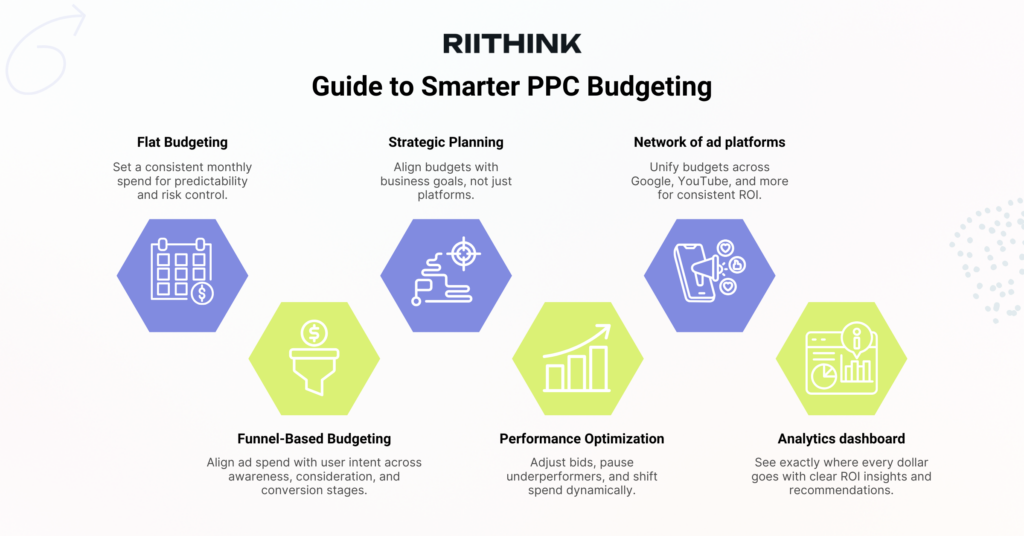When it comes to PPC, your success isn’t just about keywords or creative it’s about how you budget.
In the world of paid advertising, the line between efficient scaling and wasted spend is razor thin. Whether you’re running Google Ads, YouTube, Microsoft Ads, or even Amazon Ads, a smart PPC budgeting strategy ensures you’re investing, not just spending.
At Riithink, our PPC management services team works with brands across industries to create flexible, data-backed budget models that align with performance goals, campaign intent, and long-term ROI.
In this guide, we break down the three most common and effective PPC budgeting approaches Flat, Flexible, and Funnel-Based and how to choose the right one for your business.
Why Budgeting Isn’t Just a Number It’s a Strategy

Let’s address the elephant in the room: most businesses pick a number, slap it into Google Ads, and hit “go.”
That approach might keep the lights on, but it won’t drive long-term growth.
In reality, PPC budget models are about strategic allocation knowing when to scale, when to pause, and where to invest for the best return. This is especially important when:
- CPCs are rising (by 16% year-over-year across industries – Statista)
- Google’s AI bidding options encourage spend acceleration
So, the real question isn’t “how much should we spend?” It’s “how do we make every dollar work harder?”
Flat Budgeting: Set It, Track It, Repeat
What it is:
You commit to a consistent monthly spend say, $2,000 and stick to it regardless of seasonality, campaign shifts, or performance data. It’s steady, simple, and easy to manage.
Best for:
- Businesses with limited or fixed monthly ad budgets
- Teams new to PPC who need predictable outcomes
- Industries with little seasonal variation
Pros:
✅ Simplifies forecasting and accounting
✅ Great for beginners or cautious marketers
✅ Helps control risk when testing new campaigns
Cons:
❌ Doesn’t capitalize on surging performance
❌ Lacks flexibility during high-traffic seasons
❌ May underperform in competitive bidding markets
Example:
A small chiropractic clinic in Boise runs a $1,500 monthly search campaign. They don’t offer seasonal promos, so a flat budget ensures they stay visible without overspending even when competition spikes.
When to Use It:
If you’re running a consistent business with reliable traffic and no heavy fluctuations in demand, a flat PPC budget keeps things simple and manageable.
Flexible Budgeting: Spend More When It Works
What it is:
You start with a budget range say $2,000 to $5,000 and scale up or down depending on campaign results, cost-per-lead trends, or conversion performance.
Best for:
- Brands that monitor performance regularly
- eCommerce stores with fast-moving SKUs
- Campaigns that rely on time-limited offers or promos
Pros:
✅ Enables fast scaling of winning campaigns
✅ Lets you pause or reduce spend when performance drops
✅ More agile in reacting to market or search trends
Cons:
❌ Requires active budget oversight
❌ Difficult to forecast exact monthly spend
❌ Needs experienced management to avoid overspend
Example:
An apparel brand sees their cost-per-sale drop by 40% during a Memorial Day sale. Using a flexible budget, their PPC team boosts the campaign spend to capitalize on the momentum leading to a 2.6x return in 72 hours.
Why It Works:
According to Google, smart advertisers who respond to real-time demand can outperform static campaigns by up to 45% in seasonal periods.
Funnel-Based Budgeting: Align Spend with Customer Intent
What it is:
This model divides your PPC budget by the stages of your customer’s buying journey: Awareness, Consideration, and Conversion. Spend is guided by intent, not just channels.
Best for:
- B2B or high-ticket brands with long decision cycles
- SaaS companies with demos or free trials
- Marketing teams with strong content and retargeting strategies
Pros:
✅ Matches ad spend to user journey
✅ Drives long-term customer acquisition
✅ Builds brand authority while closing sales
Cons:
❌ Requires content strategy and funnel tracking
❌ Takes time to optimize
❌ Harder to prove ROI instantly
Example:
A B2B cybersecurity platform allocates:
- 30% to video campaigns on YouTube for brand awareness
- 40% to display retargeting with case studies and social proof
- 30% to branded search and demo signup ads
Over 3 months, they see a 28% reduction in cost-per-qualified-lead by aligning spend with user readiness.
Still Not Sure? Here’s a Quick Comparison
| Model | Predictable | Adaptable | Best For |
| Flat | ✅ Yes | ❌ No | Small/local brands with set budgets |
| Flexible | ⚖️ Moderate | ✅ Yes | Seasonal, scaling, or promo-heavy brands |
| Funnel-Based | ❌ No | ✅ Yes | Strategic, full-journey lead generation |
How Riithink’s PPC Management Services Build Smarter Budgeting Models
Budgeting isn’t a guessing game. At Riithink, we use data, testing, and real-time adjustments to help clients get the most from their PPC advertising management.
Here’s how:
1. Strategic Planning
We start with business goals, not ad platforms. Whether it’s scaling ROAS or generating qualified leads, your budget strategy is shaped around what matters.
2. Performance-Driven Optimization
Our campaigns are monitored daily and adjusted weekly. We increase bids on top performers, pause low-converting ads, and shift budget dynamically.
3. Multi-Platform Coordination
From Google to YouTube, from local service ads to global remarketing we make sure your total budget is working together, not in silos.
4. Transparent Reporting
No guesswork, no fluff. You’ll get a clear breakdown of spend by platform, funnel stage, and ROI with actionable recommendations.
Do Budgeting Models Impact Google Ads Performance?
Absolutely. Google’s machine learning rewards campaigns that align budget, bids, and intent. In fact:
- Advertisers using conversion-based budget allocation saw a 30% increase in lead quality (Search Engine Journal)
- Campaigns that reallocated budget weekly based on funnel performance outperformed static budgets by 22% in revenue growth over 60 days (SEMrush)
Final Thoughts: It’s Not About Spending More It’s About Spending Smarter
PPC success doesn’t start with your daily budget. It starts with how you think about that budget.
Are you locked into a flat model that keeps you safe but stagnant? Are you ready to scale with a flexible strategy? Or are you looking to build a full-funnel plan that grows your brand over time?
Whichever path you choose, Riithink helps you execute it with precision.
👉 Partner with our PPC Management Agency and make every click and dollar count.







